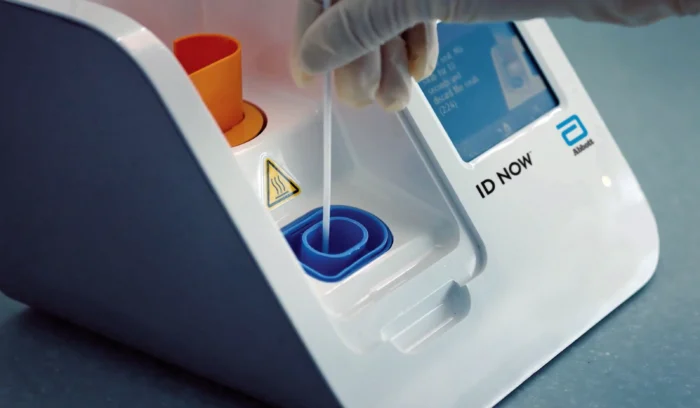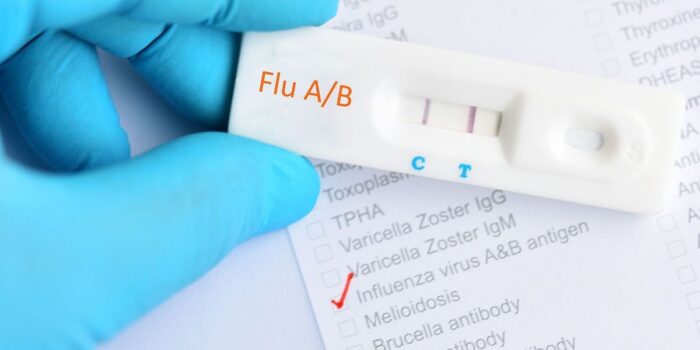
Flu season is upon us, and it is time to get our flu shots! But what if you have already caught the flu? You may feel miserable, with a fever, sore throat, fatigue, and body aches. You may wonder, “Where can I get a flu test near me?”
Flu testing is important to help confirm the diagnosis of flu and to help guide treatment. Treatment with antiviral drugs can lessen the symptoms and duration of the flu. Tamiflu is a medication that a doctor can prescribe to treat the flu.
If you are feeling sick and think you may have the flu, the best thing to do is contact your healthcare provider or Bend Urgent Care.
What is a Flu (Influenza) Test?

Flu is the short form of influenza, a virus-based respiratory infection. An influenza test can help your healthcare provider determine whether or not you are sick. If you are infected with the flu, your doctor may prescribe medicines to help combat it. The medicine is known as antiviral medicine. The best time to take it is within two days after feeling sick. Flu medicine may reduce flu symptoms and shorten the duration of your illness by one day.
There are certain times of the year when the flu is more common, called the flu season. In the US, the flu season can begin as early as October and end as late as May. People usually spread the virus by coughing or sneezing. It is also possible to spread the flu by touching surfaces with the virus and then touching your mouth, nose, or eyes.
Usually, people who have the flu suffer from muscle aches, fevers, and other unpleasant symptoms. A week or two is generally required for them to recover. In certain people, particularly children under five years of age, elders over 65, and people with chronic health conditions, the flu can cause severe illness or even death.
What are the types of flu tests?
There are several different flu tests, including:
Rapid influenza diagnostic tests (RIDTs)
The most common flu test is an RIDT, also called a flu antigen test. They can detect influenza A or B because their antigens trigger an immune response. Samples are usually taken from your nostril with a swab. The results of flu RIDTs are typically available within 10 to 15 minutes, which is faster than other flu tests. A negative rapid test result does not necessarily mean you do not have the flu.
Rapid molecular assays for flu testing

A rapid molecular assay detects flu viruses through their genetic material. Their accuracy is better than RIDTs, which take 15-30 minutes to produce results. Tests require a nasopharyngeal swab. After that, the sample is sent to the lab for analysis. Patients with flu symptoms in the hospital can also get this test.
Specialized laboratory flu tests
The accuracy of other types of laboratory flu tests is better than that of RIDTs and rapid molecular tests. Testing these changes is possible using reverse transcription polymerase chain reaction (RT-PCR). These tests are performed by healthcare providers at Bend Urgent Care who collect a sample and send it to a laboratory. It may take several hours to receive your results. It’s an acute respiratory infection caused by the seasonal influenza virus.
What are the signs and symptoms of influenza virus infection?
An influenza virus infection can cause symptoms including fever, a sore throat, runny nose, headache, muscle and joint pain, and severe malaise. A severe cough can last for two weeks or longer. Within a week, fever and other symptoms are rarely associated with medical complications. The flu, however, can be fatal for those at high risk, especially those with severe illness.
Infections can be mild, severe, or even fatal. Hospitalizations and deaths are primarily associated with high-risk groups. Influenza is the most common cause of death for people over 65 in industrialized countries. The absence of workers and schools during an epidemic can significantly affect productivity. In times of peak illness, Bend Urgent Care clinics and hospitals may become overwhelmed.
It is estimated that 99% of children in developing countries who suffer from influenza-related lower respiratory tract infections will die.
What are the types of influenza viruses?

Influenza viruses can be classified into four types, A, B, C, and D. Seasonal epidemics of influenza A and B are caused by viruses of these types.
Influenza A viruses:
Hemagglutinin (HA) and neuraminidase (NA), the proteins on the surface of the influenza A viruses, can also be used to classify subtypes. There are currently two subtypes of influenza virus circulating in humans: subtype A(H1N1) and A(H3N2). It is also called A(H1N1)pdm09 because of its ability to cause the 2009 pandemic. Before 2009, seasonal influenza A(H1N1) was in circulation. Viruses of type A have caused the only influenza pandemics.
Influenza B viruses:
These cannot be classified by subtypes but by lineages. B/Yamagata and B/Victoria are the two lineages of influenza type B virus currently circulating.
Influenza C virus:
Since influenza C occurs less frequently and usually results in mild infections, it does not pose a health threat to the public.
Influenza D viruses:
There is no evidence that influenza D viruses infect or cause illness in humans. The virus is primarily found in cattle.
Why do I need a flu test?

It is essential to consult your provider if you are experiencing flu symptoms to determine whether or not a flu test is required. Several symptoms are associated with the flu, including Fever, Muscle or body aches, Chills, Fatigue, Runny or stuffy nose, Headache, Sore throat, Cough, etc.
Flu tests may not be necessary if you have flu symptoms. If the flu is widespread in your area, your provider may not need to perform a test to diagnose you. Your provider may order a flu test if you are at high risk for more severe illnesses like pneumonia. You may be at higher risk if you have
- Insufficiency of your immune system
- Over 65 years of age
- Are pregnant
- Children under five years of age
- Have or have had cancer
- Asthma or diabetes may be chronic (long-term) health conditions
- A hospitalized patient
Exactly how does a flu test perform?
It is mandatory to take a respiratory sample for all flu tests. The following types of samples can be included:
Swabs the nasal cavity (nostrils). It would help if you inject a saline solution into your nose and gently suction it out to obtain a nasal sample. Children as young as two years old may be collected using this method. A swab through your nose is used to examine your upper throat (nasopharynx).
Flu tests: what can I expect? It is possible to feel a tickle or a gagging sensation when you or your provider swabs your throat or nose during the sample collection process. You may feel discomfort when you aspirate or wash your nose, but it is temporary.
Flu test results: what does it mean?

Positive test results indicate that you might have the flu. You may have a false positive if you test positive for the flu but don’t have the virus. Your healthcare provider might prescribe prescription medicine to prevent more severe flu symptoms.
A negative test result indicates that you may not suffer from the flu. You may be suffering from a different virus or bacteria. However, it is impossible to rule out the flu. A false negative can occur. You have the flu if you don’t know you have it, but you don’t know it.
In contrast to lab-based tests, rapid tests tend to result in more false negatives. The amount of flu virus in your body may also decrease after your test, resulting in a false negative. You might require antiviral medicine even if your test results were negative if your risk of becoming seriously ill is high. A diagnosis may also require other tests. Some tests look for flu viruses and different types of viruses. There would be separate results for each type of virus if you had a test for more than one virus.
Rapid flu tests: how accurate are they?
Antigen flu tests, often called rapid influenza diagnostic tests (RIDTs), are the least accurate method of testing for flu. Their specificity is high, and their sensitivity is moderate (50% to 70%). When a test is sensitive, it can detect whether or not an individual has a disease or illness. You are negative for the illness if you pass a specific test. It determines that you do not have a disease or illness.
It is more likely that a susceptible test will give few false-negative results, which means that fewer illnesses will be missed as a result. Since rapid flu tests have moderate sensitivity, they have a greater chance of giving false-negative results. It is rare for false-positive results to occur due to high specificity.
How is the flu test diagnosed?

In most cases of human influenza, a clinical diagnosis can be made. The influenza virus can cause Influenza-like Illness (ILI) when influenza activity is low in periods outside of epidemics, as can other respiratory viruses. These include rhinoviruses, respiratory syncytial viruses, parainfluenza, and adenoviruses, making distinguishing between influenza and other infections difficult.
The collection of appropriate respiratory samples and the application of laboratory diagnostic tests are necessary to establish a definitive diagnosis. Laboratory tests for influenza viruses must be conducted using lung specimens that have been collected, stored, and transported correctly. It is typically identified in the laboratory by direct antigen detection, virus isolation, or reverse transcriptase-polymerase chain reaction (RT-PCR) on the throat, nasal, and nasopharyngeal secretions, aspirates, or washings. The World Health Organization’s responsibility is to publish and update various guidelines on laboratory techniques.
RT-PCR methods are more sensitive and reliable than rapid influenza diagnostic tests but are less sensitive than rapid influenza diagnostic tests.
What is the treatment for flu (Influenza)?
You usually need to rest and drink plenty of fluids for flu treatment. Your healthcare provider may prescribe antiviral medication if you have a severe infection or are at a higher risk of complications. There are several types of these drugs, such as oseltamivir (Tamiflu), zanamivir (Relenza), peramivir (Rapivab), or baloxavir (Xofluza). These medications help shorten your illness’s duration and avoid serious complications.
Oseltamivir (Tamiflu Medication) is a medicine taken by mouth. Using an asthma inhaler-like device, zanamivir is administered. Those suffering from chronic respiratory conditions such as asthma or lung disease should not use this product.
A common side effect of antiviral medications is nausea and vomiting. There may be fewer side effects if you take the medication with food.
Can the flu be prevented?

Every person older than six months should receive a flu vaccine every year. There is a vaccine available that prevents the flu.
Virulent flu strains are common in the community, and vaccination doesn’t provide long-lasting immunity. That is why yearly vaccinations are recommended.
In addition to food and door handles, remote controls, handrails, telephone handsets, computer keyboards, etc., many everyday items are at risk of becoming contaminated with traces of these viruses.
It would help if you practiced good hygiene to prevent colds and flu from spreading.
When Should I See a Doctor?
If you’ve been experiencing flu symptoms for more than a few days and are not getting better, it may be time to see a doctor. If you have any of the following symptoms, you should seek medical attention immediately at a walk-in clinic:
- High fever that doesn’t go away with medication: While a fever is a common symptom of the flu, if it stays elevated for more than three days or reaches over 101°F, you should seek medical attention.
- Severe body aches: If your body aches are tough and persistent, this could be a sign of a more serious illness that needs to be addressed by a doctor or urgent care provider.
- Shortness of breath: If you’re experiencing difficulty breathing or chest pain, seek medical attention immediately. It could be a sign of pneumonia, which should be treated by a doctor as soon as possible.
- Dehydration: If you’re having difficulty keeping fluids down or are experiencing signs of dehydration, such as dizziness or dry mouth, seek medical help immediately.
- Worsening symptoms: If the flu symptoms start to get worse instead of better, it’s essential to seek medical attention as soon as possible.
It’s always best to consult with your doctor or visit an urgent care clinic if you feel unwell. Your doctor or medical provider can provide the best advice and treatment plan to help you get back on your feet.
Conclusion
If you are experiencing flu-like symptoms, getting tested as soon as possible is important. There are many flu testing centers across the country, so finding one near you should not be difficult. Once you have been tested, you can start treatment immediately. Tamiflu is a common medication prescribed for the flu and is available at most pharmacies.
There are many ways to get a flu test near you. You can visit your primary care doctor, an urgent care center, or a walk-in clinic. You can also get a flu test at many pharmacies. If you have health insurance, your insurer may have a list of in-network providers who offer flu testing. You can also search for “flu testing near me” online. Once you’ve found a few options, call to ask if they offer flu testing and to find out what their testing process is.











